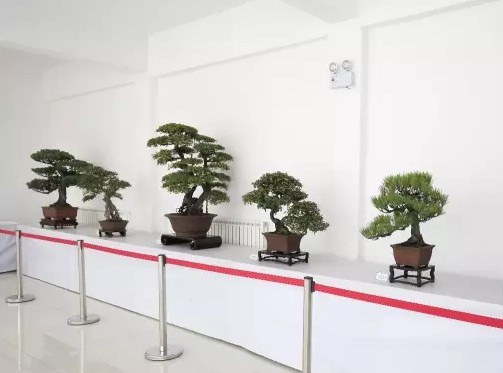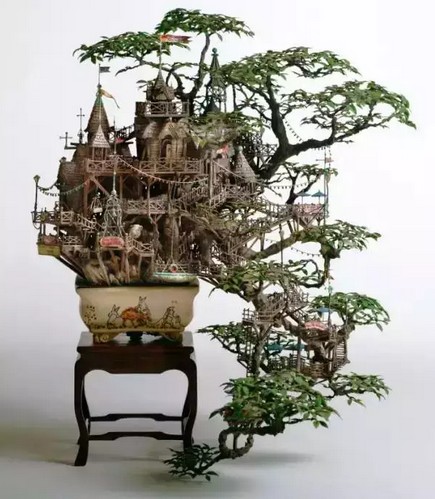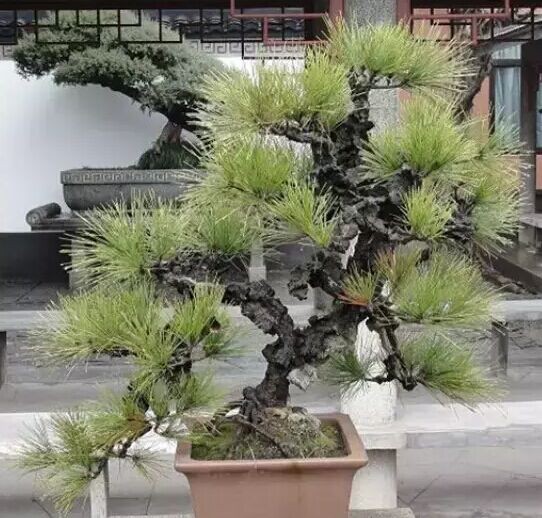The Origin and characteristics of Shanghai-style Bonsai
Shanghai-style bonsai, one of the excellent traditional arts of the Han nationality, is a bonsai art school named after Shanghai. It contains literature and aesthetics, and integrates plant cultivation, plant morphology, plant physiology, garden art and plant plastic art.

Shanghai-style bonsai is mainly distributed in Shanghai and its surrounding counties and cities. Shanghai is the largest industrial and commercial city in China and one of the largest cities in the world. Shanghai is located in the delta of the lower reaches of the Yangtze River, where the Yangtze River is crowded and has convenient land and water transportation. The climate is mild, with four distinct seasons, and has the characteristics of maritime climate. The superior natural conditions and the economic and cultural development are the main factors for the formation of Shanghai-style bonsai school.
According to textual research, Shanghai bonsai also has a history of more than 400 years. On the basis of learning and studying Chinese traditional bonsai art, Shanghai bonsai has learned from nature, deliberately sought innovation, and formed its own style step by step, and became Shanghai-style bonsai art.
Celebrate the birthday of the motherland and enjoy the bonsai of Shanghai style. However, let's find out where the Shanghai style bonsai originated, what its style is, what its master is, and what its achievement is. Let's feast our eyes on it.
The bonsai garden of Shanghai Botanical Garden was officially established in 1978 and opened to the public, covering an area of 4 hectares. Bonsai Garden as early as in 1954 Longhua nursery (the predecessor of Shanghai Botanical Garden) at the beginning of the establishment, has been a large number of collection and production of bonsai, the establishment of bonsai garden, thus becoming the birthplace of Shanghai-style bonsai. At present, thousands of Shanghai-style bonsai are collected in the park.
Shanghai-style bonsai adheres to the essence of Chinese painting art "learning from nature and ancient times into painting", embraces the strengths of other traditional schools, and creates a school of bonsai art.
The characteristic of Shanghai-style bonsai is that the tree species used in bonsai are mainly evergreen pine and cypress such as five-needle pine, real cypress, black pine, Luohan pine and so on. The production uses wire twisting and shaping, fine binding and fine cutting to construct the image. In the distribution of branches, they give up their work and return to nature. Shape processing, size collocation, abandon similarities. Therefore, the works are scattered in the performance, orderly arrangement, natural and generous, but with a profound artistic conception. In addition to the commonly used pine and cypress trees, Shanghai-style bonsai also uses deciduous color tree species such as sparrow plum, red maple, hammer elm, white wax, park tree, and flowers and fruits bonsai such as fiery thorn, golden marble, broom, pomegranate and wisteria to produce bonsai paintings like Chinese literati painting and freehand brushwork. In front of this kind of poetic bonsai, it will make people reverie.
The Shanghai Botanical Garden has successively produced four bonsai masters: Mr. Yin Zimin, the first bonsai master who made important contributions to the formation and development of Shanghai-style bonsai art, and Mr. Hu Rongqing, who is especially good at making bonsai stumps. Mr. Shao Haizhong, who is famous for large and medium-sized bonsai, and Mr. Wang Yiding, a master of landscape bonsai. The four masters can be called national treasures, laying the foundation for the status of Shanghai-style bonsai in the country, and even making inestimable contributions to the reputation of Shanghai-style bonsai in the world.
Mountain and stone bonsai is also the essence of Shanghai-style bonsai. Mountain and stone bonsai is also called three-dimensional landscape painting. Mountain and stone bonsai blend the essence of nature and show the beauty of mountains and rivers in a basin, which not only has a beautiful painting conception, but also has an elegant artistic conception. Bonsai uses natural rocks, and with the natural shape of mountains and rocks, it outlines the basic outline of landscape bonsai. The mountains and rocks sit in a flat basin, in which the still water is like a mirror, reflecting the mountains and rocks to create a picture of the landscape; or the arid flat land, the vast wilderness, but also naturally in the same appearance. Compared with the tree stump bonsai, the capacity of the landscape bonsai is larger, and there is often an artistic conception of "a spoonful of water containing rivers and lakes, mountains close to heaven and earth and autumn".
At the two world-class bonsai events held in China in 2013: the World Bonsai Friendship Alliance Congress and the World Bonsai Congress, the bonsai presented to the Shanghai Botanical Garden won the highest award, demonstrating the strength of Shanghai-style bonsai to the world.
Time: 2019-06-04 Click:
- Prev

"Sichuan School" in Chinese Bonsai Art
Bonsai is a work of art with plants and rocks as the basic materials to show the natural landscape in the basin, which is called three-dimensional painting and silent poetry. The bonsai in China originated from the potted plants 7000 years ago, and it appeared in the Han Dynasty. The bonsai began to develop in the Northern and Southern dynasties, and turned to poetic painting in the Tang Dynasty.
- Next

Shanghai-style bonsai: learn from nature, chic and elegant, not stick to one style
Shanghai-style bonsai is composed of tree bonsai, landscape bonsai, miniature bonsai and so on. Learning from nature, chic and elegant, and not confined to one style, among the five traditional bonsai schools in China, only Shanghai-style bonsai is worthy of the above 12 words. It seems unthinkable not to see it with one's own eyes, no more than a meter at most and only a few inches at a minimum.
Related
- Fuxing push coffee new agricultural production and marketing class: lack of small-scale processing plants
- Jujube rice field leisure farm deep ploughing Yilan for five years to create a space for organic food and play
- Nongyu Farm-A trial of organic papaya for brave women with advanced technology
- Four points for attention in the prevention and control of diseases and insect pests of edible fungi
- How to add nutrient solution to Edible Fungi
- Is there any good way to control edible fungus mites?
- Open Inoculation Technology of Edible Fungi
- Is there any clever way to use fertilizer for edible fungus in winter?
- What agents are used to kill the pathogens of edible fungi in the mushroom shed?
- Rapid drying of Edible Fungi

